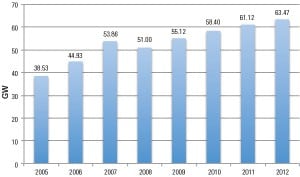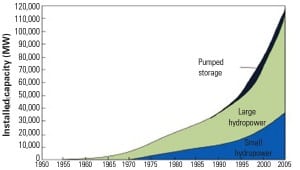As the global electric power industry continues to develop clean, high-quality energy capacity for sustainable development, the position of small hydropower has changed. In the past few decades, small hydropower development in China has experienced positive momentum, but there are still problems to be solved. To solve these problems, various relationships within the small hydropower industry must be rationalized to enable the sector to advance.
Editor’s Note: A condensed, one-page version of this article will appear in the January 2015 print issue of POWER.
Around the world, the electric power industry is on its way toward clean and high-quality energy capacity additions for sustainable development, rather than simply to meet electricity demand. Due to significant changes in external conditions, stricter environmental requirements have become important constraints on power industry development. One of the most controversial issues is related to large hydropower.
According to some estimates, all the hydropower stations worldwide provide 19% of the planet’s electricity and contribute to a reduction of approximately 539 million tons of carbon dioxide emissions. However, considering the impact of large hydropower projects on soil, water, vegetation, living things, climate, and human activities, plus the lack of protection for the watershed environment, some large-scale hydropower projects are regarded as being not in harmony with the environment. Therefore, it is thought that large hydropower is unfavorable to socially sustainable development. Some policies to hinder large hydropower development have led to a declining proportion of large hydropower in worldwide total installed capacity, further prompting a shift in hydropower development to small hydropower (SHP).
In addition, with deepening power system reform, and taking into account requirements of the Kyoto Protocol (which expired at the end of 2012), new mechanisms for power development and management, including the Kyoto Protocol’s Clean Development Mechanism (CDM), have been formed. Small, independent power producers (IPP) owned by various types of investors are increasing, and a theory and operational method of distributed power supply (DS) have emerged, thus the definition of “small hydropower” and its position in the electric power industry have changed.
This article first reviews the development status and characteristics of China’s SHP sector and analyzes existing problems in the development process and then proposes solutions to those problems. Finally, we look to the future of China’s SHP development.
The Status Quo for Small Hydropower in China
The Chinese government has always attached great importance to the construction of small hydropower. SHP construction in China was initially aimed at supplying electricity for mountainous areas in collaboration with small-scale water conservancy projects.
The last decade saw large-scale constructions of thousands of megawatts, which were put into production several years in a row. For several decades, China’s SHP sector has flourished and has attracted considerable attention of relevant United Nations departments. It was said that the miracle of SHP development in China was a model for developing countries wanting to address energy issues on their own and accelerate the local development of regions.
From the perspective of development potential, China’s SHP resources are very abundant, with an economic development capacity of about 120 GW, widely distributed over 1,600 counties (cities) across the country. By the end of 2011, more than 45,000 SHP stations were built with a total installed capacity of 62 GW (Figure 1). SHP installed capacity and annual power generation accounts for about 27% of China’s hydropower.
1. Total installed capacity of small hydropower stations in China. Source: China Electricity Council (www.cec.org.cn/) and State Electricity Regulatory Commission (www.serc.gov.cn/)
Installed SHP capacity is mainly concentrated in Guangdong and another 20 provinces and cities, while the capacity in Sichuan, Fujian, Yunnan, Hunan, and Zhejiang provinces accounts for 60% of the national capacity. This shows that small hydropower is a high-regional-concentration industry, reflecting the dominant role of the local resources and local government in its development.
In 2012, the Ministry of Water Resources, in conjunction with the National Development and Reform Commission, promulgated “The Management Approaches of Small Hydropower Substituting for Fuel Projects.” Investment from the central government continues to increase. As a result, since 2009, 242 of these ecological protection SHP projects have been approved for construction, adding 625 MW of installed capacity. These SHP projects are financed and constructed through national compensation and return farmland to forest (grassland) area and nature reserves, mainly to replace fuel necessary for daily life and to provide cheap electricity for rural residents. At the end of 2012, 105 ecological protection projects of SHP substituting for fuel had been completed with an addition of 212 MW, thereby providing energy for basic daily life for more than 60 million rural residents and protecting 2.2 million acres of forest that might otherwise have been flooded for large hydropower impoundment/dam projects.
Adding and Financing New Hydro Capacity
In the 12th Five-Year Plan, the country plans to add 160 GW of hydropower, with 40 GW pumped storage capacity. Of the added capacity, 74 GW is to come from new installations, with SHP providing 10 GW of that total plus 13 GW of pumped storage capacity. This clearly points out that the central government needs to strengthen the comprehensive management of small and midsize river basins, promote the increased capacity and efficiency of hydropower, improve the development and utilization level of SHP in poor areas with abundant resources—combined with hydropower construction in new rural areas while implementing the “small hydropower takes place of fuel” project (detailed below). By 2015, the construction of five SHP provinces with 3 GW—Jiangxi, Guizhou, Hubei, Zhejiang, and Guangxi—and five SHP with 5 GW— Hunan, Guangdong, Fujian, Yunnan, and Sichuan—will be completed.
In addition to rapid development, a unique approach to managing SHP in China was created. Several SHP stations with social features mainly invested in by various levels of governments were gradually constructed, as well as SHP plants depending on collective and individual investments for the purpose of making a profit.
There are three main financing methods for SHP:
- Capital market financing. First, most of the current national and local water conservancy and hydropower companies are listed corporations, so they can get financing directly from the capital market. Second, the cooperation of SHP enterprises and listed corporations is the channel of capital market financing. Third, they can get financing through the issuance of firm financing bonds.
- Fund financing. A China electric power construction fund was created in 1998, in which the subjects were all enterprises and the standard fee was 2 cents per kilowatt. The fund has a designated account, but this policy has been abolished.
- Resource financing. In recent years, SHP resources are paid to sell electricity, so they have been a way for SHP construction and management financing. These funds are mainly used for SHP construction management, state-owned power plant transformation, and emergency use.
Further, the development of SHP leads to the expanding of local power grids in China, causing changes in the electricity consumption structure of SHP-supplying regions, ensuring the continued growth of the townships’ industrial and rural household electricity consumption. The township, village, and household power-access rates in SHP-supplying regions increased from 91.8%, 78.1%, and 65.3% in 1985 to 97.3%, 97.5%, and 96.1% in 2001, respectively. Therefore, the problem of supplying electricity for about 300 million rural citizens was basically solved. Figure 2 shows the share of China’s installed capacity of SHP and the growth of generating capacity.
2. Installed hydropower capacity. Source: China Electricity Council (www.cec.org.cn/) and State Electricity Regulatory Commission (www.serc.gov.cn/)
Development Characteristics
Several aspects of SHP development are unique to China.
Decentralized Management System Dominated by Local Regions. Distinguished from concentrated development and projects implemented by the central government in other developing countries, or developing a single power station mainly by enterprises with the goal of economic gain in some countries of Europe and in the U.S., China’s SHP development and management is decentralized and implemented by local regions.
While the development strategy, objectives, standards, guidelines, and policies of SHP are formulated by the central government, other planning plus design, development, operation, management, and equipment manufacturing for SHP are undertaken by local governments. Based on the “walking on two legs” policy of self-reliance, SHP projects are developed locally and extend the electricity supplied by large power grids, thereby forming a decentralized management system. Table 1 compares management styles for SHP development.
Table 1. Comparison of management styles for small hydropower development. Source: http://www.cec.org.cn
Preferential Supporting Policies Designed for Local Regions. For a long time, the Chinese government has formulated a series of preferential policies to encourage local governments and people to develop rich SHP resources in mountainous areas. The three-self principle of “self-built, self-management, self-use” promulgated in the early sixties has guided China’s SHP development.
The “self-built” principle allows and encourages local governments and people to carry forward the hard work and self-reliant spirit to plan and build local SHP stations using local resources, technologies, and raw materials. “Self-management” refers to “who invest who owns,” ensuring the enthusiasm of the local electricity office. “Self-use” means the electricity generated from SHP stations shall be issued to the nearest local use, which requires that SHP must have its own supply (“distribution”) areas, forming a unified and integrated rural electricity market.
Furthermore, taking the tax policy as an example, the value-added tax levied on SHP has been 6% of the income since 1994, which has an advantage over the large hydropower value-added tax of 17%.
Multiple Channels for Collecting Construction Funds. SHP is expected to be developed through multiple channels, levels, and modes. The government encourages farmers to invest personally or collectively, and also encourages enterprises to invest in the joint-stock or stock cooperative system. Foreign funds and foreign capital are allowed to invest in power plants. In short, whoever wants to invest is welcomed.
The policy of “who invests, who owns, who benefits” is implemented. Therefore, various types of SHP accounting units have been formed. From the central to local governments, several hundred million dollars was arranged for SHP construction every year.
In recent years, China has invested more in promoting electrification construction and delivering electricity to remote areas and is actively arranging funds for “small hydropower substituting for fuel” projects. Over the past decade, financial institutions have gradually become the main source of funds. Furthermore, some banks set up special loans to support local SHP construction. With the further development of the market economy, the role of financial institutions will be more and more prominent.
Close Coordination with Chinese Rural Electrification Construction. For China, an old and giant country, economic development and resource conditions vary from region to region. It is unrealistic and uneconomical to achieve rural electrification by completely relying on the central government to develop power generation and by relying on large power grids to supply electricity. Therefore, adhering to the policy of “walking on two legs,” the electrification of SHP resource-rich mountainous rural areas is allowed first. And here, power quality is higher than in urban areas, and the range of resources supplying power is more diverse, which is favorable for the state, group, and individual.
In 1983, the State Council decided to launch SHP pilot projects in 100 SHP resource-rich counties, laying the foundations for Chinese rural electrification, and therefore determining a unique way to develop large-scale SHP construction with rural electrification as the driving force.
Focus on Economical and Practical Technologies for Small Hydropower. The rapid development of SHP in China’s rural areas is attributed to the emphasis on economical and practical SHP technologies compatible with the level of development in China’s rural areas throughout the construction process. From pre-planning to design, construction, installation, inspection, operation, and more, a set of technical regulations, norms, and standards have been developed to ensure construction quality, cost-efficiency, and on-time project completion.
In addition, new technologies and products have been promoted, such as hydropower optimal scheduling, inter-basin power development, and so on. The application of those new technologies and products not only saved investment, it also shortened the construction period, improved the reliability of supply, and created a lot of records in China’s hydropower construction history.
Formation of Local Power Grids and Power Supply Areas. Unlike other developing countries, China attaches great attention to the development of SHP’s own supply (“distribution”) area, and has formed a unified system integrating power generation, supply, and consumption in SHP resource-rich areas with local SHP companies in charge of supplying power to rural areas. Local power grids and the national grid can connect at a certain point in order to take full advantage of seasonal electricity supplies.
Issues to Be Resolved
As with most power generation development projects, SHP development in China faces a number of challenges.
Property Rights. Over the years, the public welfare aspect of SHP has been the focus, and less attention has been paid to the property rights of power stations. When competition in the electricity market is intensified, plus the external administrative intervention and a mess of internal mechanisms, electricity market confusion is likely to emerge in the SHP supply region.
In this regard, the conditions in some developed countries are much better. The U.S. launched rural electrification in 1935 with the Rural Electrification Act, and today, about 11% of electricity and three-quarters of the U.S. is powered by more than 1,000 rural electrification cooperatives. In China, rural electrification cooperatives are nonprofit electricity enterprises organized by rural users and shareholders, implementing the mechanism of “self-occupy, self-supply, self-use.” Their property rights can only be changed through the conversion of stakes, resulting in a rural electricity market with clear property rights. For the future of rural areas in China, a stable rural electricity market is needed.
Decentralized Operation. Considering the economic strength of a single power station, SHP is a vulnerable industry. The development of SHP in the future depends largely on whether its social benefits, environmental benefits, and welfare status will be recognized by the whole society. To some degree, because society as a whole is the beneficiary of the social and environmental benefits of SHP development, it is reasonable for the whole society to pay a certain price, which is also a “win-win” arrangement. But the problem is that society does not take the initiative to pay such costs.
Lack of Enthusiasm for the Development and Application of Advanced Technologies. In general, SHP technologies should be compatible with the local development level, striving to enable simplicity and low-cost development and management. However, operators often focus only on the immediate benefits, lacking long-term awareness, and are unwilling to spend money to engage in technological innovation (Figure 3).
3. Innovation in small hydropower technologies is needed. The tubular turbine developed by Emeishan turbine factory in Sichuan Province is popular because of its characteristics of high efficiency and resistance to corrosion. Courtesy: Baidu Inc.
Institutional Issues. After 1998, China began to carry out large-scale “two reforms and one price” work, which referred to reform of the rural power management system, the transformation of rural power grids, and achieving the same price in urban and rural power networks. Due to the relevant departments’ one-sided understanding of the State Council’s documents, they expanded their monopolistic range, encroached on local interests, harmed the interests of the masses, and created institutional barriers depending on “two reforms and one price,” making any measure promoting the development of SHP policy measures difficult to enforce.
Supply Areas and Grid-Access Issues. The well-established policy of “small hydropower should have its own power supply areas” has greatly promoted development of SHP and rural electrification. However, there is an inherent conflict with this principle because all generating capacity must access a large grid. Further, the central power enterprises with a monopoly position allow less grid-connected electricity for SHP generation enterprises (Figure 4), so the excess is called “invalid electricity.” Even if it is integrated in the grid, there is almost no profit. Meanwhile, the tariff for SHP is also far lower than that of thermal power. As a result, this unreasonable situation is a severe blow to the development of small hydropower.
4. Grid access is lacking. The 110-kv substation in Guanyinyan project in Yunnan Province helps to connect small hydropower, improve the quality and reliability of power supply, and solve the bottleneck of local SHP development. Courtesy: Baidu Inc.
Needed Countermeasures
Several changes are needed to improve the SHP sector.
Deepening Power System Reform. Electric power system reform is directed at breaking the monopoly; establishing a balancing mechanism; implementing the principle of “neutral scheduling, separating plants from grids, bidding for electric network, separating transmission from distribution, competitive supplying”; and, ultimately, cultivating an orderly electricity market with orderly competition based on relatively stable electricity service areas and a rational tariff mechanism.
Local SHP enterprises generate power mainly for local use, with excess electricity to access large grids. When local electricity generation is not enough, local grids must purchase electricity from large power grids. In short, SHP enterprises are local, independent distribution companies with the integration of generation and supply (distribution). Therefore, for local SHP enterprises, it is impossible to make scattered, small, stand-alone capacity power stations participate in the reform of “separating plants from grids, bidding for electric network” on the generation side. Rather, on the basis of balancing electric power and energy, local SHP enterprises should carry out reforms on the distribution side to promote electricity market development.
Implementing a Renewable Energy Quota System. The basic intent of a renewable energy quota system is that a certain proportion of renewable energy generation should be maintained in regional power construction. Further, its essence is that the electricity generated from renewable energy in different regions with almost the same quota proportion can be traded to address the differences of renewable energy resources of different regions.
The characteristic of this policy is to change the supporting method for renewable energy from direct government subsidies in the past to a market-oriented adjustment. In the “10th Five-Year Plan,” SHP with installed capacity below 25 MW had been included in the list of renewable energy supported by national policies. The implementation of a renewable energy quota system can ensure grid access for SHP and further accelerate the pace of electric power industry reform.
In addition, the separation of plants and grids is aimed at gradually forming a national electricity market with spot and futures trading, which will help to promote the widespread implementation of renewable energy quota system in our country.
Achieving SHP Industry Innovation. In the future, a theory of the SHP industry is required for this sector’s development. For example, it is necessary to prove SHP enterprises to be nonprofit enterprises in special form. SHP has a lot of social and environmental benefits that cannot be replaced by commercial behaviors, including: rural electricity supply; comprehensive management of mountains, water, forests, and roads; rural environmental protection, poverty alleviation, and promoting social stability and economic development in local areas.
Because SHP enterprises have delivered huge social and environmental benefits, but the enterprises themselves have not paid off, SHP enterprises can only be categorized as nonprofit enterprises. The construction of SHP itself expands the local economy in essence; therefore, continuing to rely on the local government construction management system should be theoretically proved rational.
The Outlook
The establishment of the International Center on Small Hydropower in China is one of the major achievements of China’s reform and a symbol of world SHP demand, which reflects the international status of China’s SHP development. The center, located in Hangzhou, has created a new model of cooperation for developing countries, developed countries, and international organizations. The center includes member organizations in more than 60 countries and has established four “bases,” which are used to hold small hydropower meetings and carry out industrial experiments: Chenzhou base, Zhangye base, JinHua turbine manufacturing base, and Changsha hydropower control device manufacturing base (Figure 5).
5. SHP centers have flourished. Longshou hydropower station is located in Zhangye SHP base of Gansu Province in China. Taking the advantage of abundant water resources in Heihe Mainstream, there are eight SHP projects with a total installed capacity of more than 1 GW in Zhangye. Courtesy: Baidu Inc.
After decades of development, China’s SHP design, construction, and equipment manufacturing capacity have made considerable progress. Currently, counties that develop hydropower and affiliated power equipment and achieve acceptance codes of hydropower electrification promulgated by our country have the ability to construct power stations with an installed capacity below 3,000 kW and 35 kV power transmission and transformation projects. Some counties in particular can rely on their own technical abilities to construct SHP stations of 25,000 kW and 110 kV power transmission and transformation projects. In all, China already has the ability to complete any foreign SHP projects. Therefore, exploring global expansion and constructing SHP projects successfully would not only can yield economic benefits but also promote friendship between China and other countries.
Overall, the role of SHP in promoting socioeconomic development and environmental protection in China’s rural areas has become increasingly important. The SHP industry is no longer a means just to solve rural energy problems but also provides a combination of social, economic, and environmental benefits. To solve problems in China’s SHP development process, the country needs to rationalize the various relationships within the industry, especially with the large grid, make clear the position of the SHP industry in the future, and strengthen the functions of hydropower departments at all levels. Only in this way can problems be worked out gradually from top to bottom, promoting the next phase of small hydropower development.
—Dr. Liu Ximei (meimeiliu126@163.com), Prof. Zeng Ming, and M.A. He Yanying are in the School of Economics and Management, North China Electric Power University, Beijing, China.
















